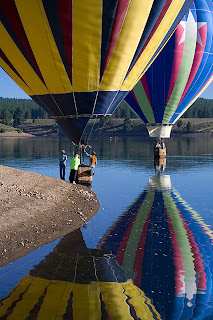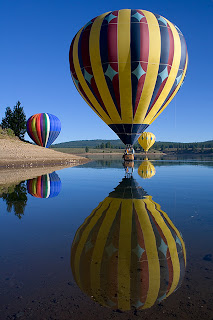 Polarizing filters are fairly well known for being able to darken a blue sky and increase contrast with white clouds in a scene, for reducing glare and reflections (off of water, cars and so forth), and for cutting haze and bringing out more subtle shades and detail in clouds.
Polarizing filters are fairly well known for being able to darken a blue sky and increase contrast with white clouds in a scene, for reducing glare and reflections (off of water, cars and so forth), and for cutting haze and bringing out more subtle shades and detail in clouds.What some people don't know is that they can improve the color and saturation in fall color photos by reducing glare and reflection off of the leaves, improve detail in outdoor photos with a lot of sandstone or granite in them, and improve the color saturation of other objects that can reflect light shot in the sun (such as hot air balloons, buildings, even insects). In addition, reducing glare on peoples' skin may save some of those shots that were marginal for you in the past because the camera closed down another stop or two and faces came out too dark.
The first key thing to pay attention to is that you buy a circular polarizer, not a linear polarizer. A circular polarizer should be compatible with your camera's autofocus system.
When you're using the polarizer, you can rotate it to increase or reduce its effects on the photo. For even more control, there's a mark on the rim of the filter and the light is cut most in that orientation (from that direction). For example, if you point that mark straight up, you can virtually eliminate a reflection on a reflective surface such as water. If you point that mark straight sideways, the reflection on water in front of you will be preserved, but glare on objects from light coming from the side of you (a rising or setting sun) will be dramatically reduced.
The easiest way to use a polarizing filter is to simply try to point that mark at the sun (or other main light source), then perhaps make a minor adjustment to affect any desirable reflections in the photo a little more or less.
A slightly more advanced application might be to try one for shots involving clouds, whitewater, steam, or snow, to see if you can get more finely-tuned shades of white and gray and more detail in your photo once you reduce the glare. You may be amazed at what polarizers can do for clouds. You may have to bracket exposures and try various angles on the polarizer to get just the right combination to bring out the subtle detail, and you may not be able to tell any difference among those shots until you get back home to your PC.
The circular polarizers I've bought tend to be in the $20-30 range for a fairly small and common filter size, but they do get more expensive with size and they cut the light coming into the camera about 2 stops. Two stops usually isn't a big deal in sunlight, which is when you most often need these filters. I don't trust the cheapest, I tend go with a reasonably priced option among brand names.
On a clear, blue sky day, polarizers tend to have the most applications in bright light and in mid range shots. Wide angle lenses cover a lot of the sky and the polarization of the sky varies across the shot, resulting in the filter's effect being applied unevenly and the color and darkness insonsistent across the shot.
I hope you can see that circular polarizers can have a range of applications and don't have to cost a lot. They tend to be the second filter that nearly all shops recommend that you buy, right after a UV or Haze filter to protect the front surface of your lens.
In these examples the zoomed shot was taken with the polarizer pointing sideways towards the sun, cutting glare on the balloons and enabling a more even exposure of them without killing the reflection. In the second, wider example the filter is rotated further off of horizontal and the polarization of the light reflected off of the lake varies, enabling the texture of the bottom of the lake to show through.
 Options include thin polarizers for wide angle lenses, which are less likely to cause vignetting the corners of in your shots. Some still have front filter threads, but many wide angle filters require a special snap-on filter cover. Some polarizers have extra coatings to reduce flare and ghosting, which may be particularly worthwhile if you expect to have the sun in some of your shots.
Options include thin polarizers for wide angle lenses, which are less likely to cause vignetting the corners of in your shots. Some still have front filter threads, but many wide angle filters require a special snap-on filter cover. Some polarizers have extra coatings to reduce flare and ghosting, which may be particularly worthwhile if you expect to have the sun in some of your shots.You can also use a polarizer as a neutral way to cut light (as a neutral density filter), to enable you to artistically blur rivers and streams, waves, trees blowing, or boats rocking.
No comments:
Post a Comment